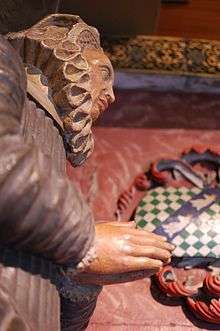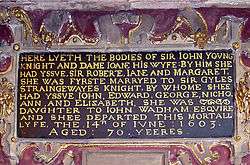John Young (16th-century MP)


Sir John Young (by 1519 – 4 September 1589), of Bristol, London and Melbury Sampford, Dorset, was an English politician.
He was the eldest surviving son of Hugh Young of Bristol and Castle Combe, Wiltshire who he succeeded in 1534.
He was a Member (MP) of the Parliament of England for Old Sarum in 1547 and 1571, Plymouth in 1555, Devizes in 1559, and West Looe in 1563.[1]
He was appointed High Sheriff of Dorset for 1569–70 and was a Justice of the Peace for Dorset and Somerset from c.1573. He was knighted in 1574 by Queen Elizabeth I when she stayed with the Youngs at the Great House in Bristol that year. Sir John began construction of the house in 1568. The only surviving part of the estate today is the Red Lodge, completed by Joan, Lady Young in 1590, which is open today (2016) as the Red Lodge Museum, Bristol.[2]
He married Joan Wadham, the daughter of John Wadham of Merryfield, Ilton Somerset and Edge, Branscombe Devon, sister and co-heiress of Nicholas Wadham co-founder of Wadham College, Oxford, and the widow of Sir Giles Strangways of Melbury Sampford, Dorset. They had a son and 2 daughters.
Sir John died at Bristol in 1589 and Joan Wadham lies buried with him in Bristol Cathedral in a magnificent altar tomb which bears the armorials of both her husbands, Strangways and Young, beneath the arms of Wadham.
Archives
Deeds of the Red Lodge, including a record of John Young's transaction with the previous owner of the land, Francis Rowley, are held at Bristol Archives (Ref. 5535) (online catalogue). These deeds also contain details of later owners of the Red Lodge, including Lady Byron and Mary Carpenter.
References
- "YOUNG, John I (by 1519-89), of Bristol, Glos.; London and Melbury Sampford, Dorset.". History of Parliament Online. Retrieved 30 May 2013.
External links
- Feuding Gentry and an Affray on College Green, Bristol, in 1579 Bettey, J.H. in Transactions of the Bristol and Gloucestershire Archaeological Society (2004) Vol. 122, pp 153–159. ("During the 1570s two wealthy, landed gentlemen engaged in a struggle for primacy in Bristol. They were Hugh Smyth, who possessed Ashton Court together with widespread estates in Somerset and south Gloucestershire, and John Young, owner of properties in Somerset, Wiltshire and Dorset. Their rivalry was to involve several other gentry families in the district, and culminated in a violent confrontation between their armed retainers on College Green in March 1579.")